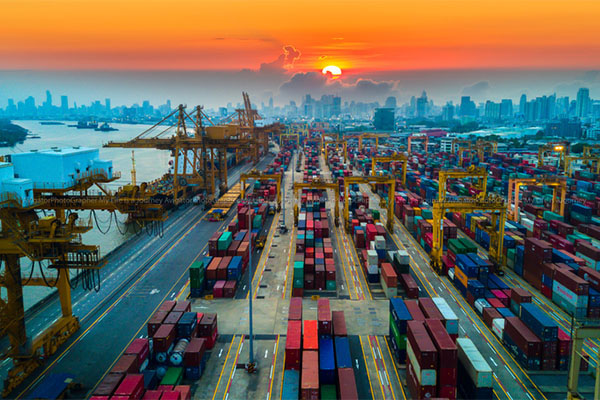Port Tracker report reinforces expectations for declining import volumes over remainder of 2022

In line with its previous edition, the new edition of the Port Tracker report, which was issued today by the National Retail Federation (NRF) and maritime consultancy Hackett Associates, reiterated that United States-bound retail container volumes are expected to come in below 2021 levels over the balance of 2022, with both inflation and the expected actions to be taken by the Federal Reserve taking action to reduce demand in the form of higher interest rates, serving as key drivers for the report’s expectations.
The ports surveyed in the report include: Los Angeles/Long Beach; Oakland; Tacoma; Seattle; Houston; New York/New Jersey; Hampton Roads; Charleston, and Savannah; Miami; Jacksonville; and Fort Lauderdale, Fla.-based Port Everglades.
Authors of the report explained that cargo import numbers do not correlate directly with retail sales or employment because they count only the number of cargo containers brought into the country, not the value of the merchandise inside them, adding that the amount of merchandise imported provides a rough barometer of retailers’ expectations.
“Consumers are still buying, but the cargo surge we saw during the past two years appears to be slowing down,” NRF Vice President for Supply Chain and Customs Policy Jonathan Gold said in a statement. “Cargo volumes are solidly above pre-pandemic levels, but the rate of growth has slowed and even slid into negative numbers compared with unusually high volumes last year. The key now is dealing with ongoing supply chain issues around the globe and with labor negotiations at West Coast ports and freight railroads. Smooth operations at the ports and on the rails is crucial as we enter the busy holiday season.”
What’s more, the report pointed to various events and issues impacting import volumes, including: the July 1 expiration of the International Longshore and Warehouse Union (ILWU), which saw a good number of retailers import earlier than normal and also shift to East and Gulf Coast ports to avoid potential disruptions, with these earlier shipments pacing volumes; and freight railroads and rail labor unions in negotiations following recently-released Presidential Emergency Board recommendations.
For July, the most recent month for which data is available, import volume—at 2.18 million TEU (Twenty-Foot Equivalent Units)—was 3.1% below June and off 0.4% annually, marking the third annual decline in the last two years (through July) and for the first time since December 2021.
For the following months, Port Tracker issued the following projections:
- August, at 2.17 million TEU, for a 4.3% annual decrease;
- September, at 2.1 million TEU, for a 1.8% annual decrease;
- October, at 2.1 million TEU, for a 4.8% annual decrease;
- November, at 2.04 million TEU, for a 3.3% annual decrease;
- December, at 2.01 million TEU, for a 4% annual decrease; and
- January, at 2.11 million TEU, for a 2.6% annual decrease
Total first half 2022 volume came in at 13.5 million TEU, for a 5.5% annual increase, with the report calling for the second half of the year to hit 12.6 million TEU, for a 3.1% annual decrease, with total 2022 volume expected to be up 1.2% over the current record of 25.8 million TEU set in 2021, to 26.1 million TEU.
Hackett Associates Founder Ben Hackett wrote in the report that the odds of a decline in import volumes remains high, for various reasons.
“The continuing closures of transportation chains and manufacturing in China are a disruptive factor for the supply chain and for shipping lines trying to address the ongoing unreliability of their schedules, noted Hackett. “Our forecast going into 2023 predicts further declines in imports in the first half of the year. On the positive side, the number of vessels waiting to dock on the West Coast has been reduced to near-normal. But with the switch of some cargo to the East Coast, congestion and pressure on the ports remains—just at different ports. The inland supply chain, particularly rail, continues to face difficulties that have resulted in the delay of containers leaving ports, causing terminal congestion that impacts the ability of carriers to discharge their cargo.”

Article Topics
3PL News & Resources
April Services PMI contracts after 15 months of growth, reports ISM 2023 industrial big-box leasing activity heads down but remains on a steady path, notes CBRE report Q1 U.S. Bank Freight Payment Index sees shipment and spending declines Ryder opens up El Paso-based multi-client facility logistics facility April manufacturing output takes a step back after growing in March TIA rolls out updated version of framework focused on fighting freight fraud National diesel average is down for the third consecutive week, reports EIA More 3PLLatest in Logistics
Preliminary April North American Class 8 net orders are mixed Senators take a close look at Amazon with Warehouse Worker Protection Act Despite American political environment, global geopolitical risks could be easing Maryland DOT: $1.9 billion and up to four years to rebuild bridge sunk near Baltimore port April Services PMI contracts after 15 months of growth, reports ISM 2023 industrial big-box leasing activity heads down but remains on a steady path, notes CBRE report Comau’s Advanced Solutions Drive The Benefits Of Automation For Diversified Industries More LogisticsAbout the Author
Subscribe to Logistics Management Magazine

Find out what the world's most innovative companies are doing to improve productivity in their plants and distribution centers.
Start your FREE subscription today.
May 2024 Logistics Management

Latest Resources














